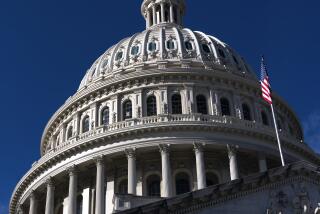How to Fix Politics? Believe It or Not, More Politicians
- Share via
There are currently 435 members of the U.S. House of Representatives. In a country of 290 million people, that means that each congressional district has nearly 670,000 people. That is ludicrously large -- and it is not the way the House was intended to work.
There is no constitutional rule that says the House has to remain at 435 members. On the contrary, the framers assumed that the House would keep up with population growth. Thus the Constitution requires a census for allocating seats and gives the House authority to adjust them by majority vote.
In the 1st Congress, the 65 House members each represented about 60,000 people. Throughout the 18th and 19th centuries, as states were added and subtracted, and the population grew, the House frequently resized itself. In 1913, the 63rd Congress jumped from 391 to 435 seats -- and a district still only included about 200,000 people.
But that’s when it stopped. The general confusion and displacements during World War I, the Depression and World War II made the censuses of 1920, 1930 and 1940 seem provisional, and there were no increases. The calmer 1950s would have been the time to resume regular increases, but the House opted to go on doing nothing. Meanwhile, the population kept growing.
The problem is this: In districts of 670,000 people, legislators tend to lose touch with voters. Campaigns become more expensive. Dollars come first, constituents second. Ordinary people can’t afford to run for office. Democratic representation, at least as the framers understood it, doesn’t happen except by accident.
Special interests, for the most part, become disproportionately important under this system. They write the major pieces of legislation. In the key area of defense spending, patronage to sprawling districts ensures audit-free procurement, more often than not unrelated to real national security needs.
The House routinely fails, furthermore, to demonstrate serious interest in policy outside of its cash register.
In short, members in enormous, impersonal districts develop priorities that serve neither constituents nor country. We have traded a reasonably fair social covenant for unchecked depredations by the well connected against everybody else, along with a loss of balance-of-powers protections against presidential aggrandizement.
It’s a disaster. And it’s anti-democratic. Americans face a crisis: Will the institution most charged with democracy represent people or lucre?
The only way to restore genuine democratic representation is a substantial, long-overdue increase in the size of the House. We need a fivefold increase now, and a longer-term goal of maintaining districts of about 100,000 people.
It’s mind-boggling, to be sure, to contemplate a House of 2,000 or 3,000 seats, or more. Such a change would cause huge disruptions. But reluctant as we may be to do it, the alternatives are far worse. Let’s not quibble over practicalities.
It is a disgrace that the House’s districts are larger than those of every other democratic country in the world except India. Among the countries in the European Union, for example, the median size of a comparable district is 45,000 people. In Britain, the House of Commons has districts of about 70,000 people. These countries have found ways to expand their legislatures. So must we.
What’s needed is a grass-roots movement to take back the House a seat at a time until a majority exists to multiply its membership. The civil rights movement is a model of how to do this. It can happen. The decisive test is whether we have the judgment to want it.
More to Read
Get the L.A. Times Politics newsletter
Deeply reported insights into legislation, politics and policy from Sacramento, Washington and beyond. In your inbox twice per week.
You may occasionally receive promotional content from the Los Angeles Times.










